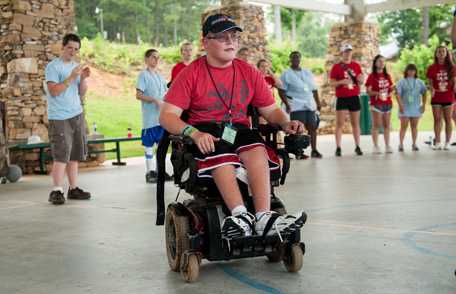CDC’s New Muscular Dystrophy Research
 CDC’s Muscular Dystrophy Surveillance Tracking and Research Network is the only population-based muscular dystrophy tracking program in the United States. This program addresses gaps in public health research of muscular dystrophy.
CDC’s Muscular Dystrophy Surveillance Tracking and Research Network is the only population-based muscular dystrophy tracking program in the United States. This program addresses gaps in public health research of muscular dystrophy.
Public health research of muscular dystrophy
Muscular dystrophy is medically complex, often requiring care from multiple specialists. These specialists may be affiliated with a muscular dystrophy specialty clinic. Research data is often collected at these clinics since they treat a large number of individuals with muscular dystrophy. However, using clinic data from only large clinics leaves out those with muscular dystrophy who don’t receive care at one of these specialty clinics. Population-based public health tracking of rare conditions like muscular dystrophy can answer questions that are difficult to address with information collected only from specialty clinics. Population-based tracking captures a picture of those with muscular dystrophy who receive medical care in a variety of environments within a specific geographic area.
CDC’s MD STARnet (Muscular Dystrophy Surveillance Tracking and Research Network) is the only population-based muscular dystrophy tracking program in the United States. Data from the five participating MD STARnet locations document:
- How common each type of muscular dystrophy is in the population.
- How long it takes for a diagnosis to be made, diagnostic tests received, and age at confirmation of diagnosis.
- Types of medical services, medications, surgeries, and therapies received.
- Types of clinics and healthcare professionals who care for people with muscular dystrophy.
- How services and treatments affect outcomes and quality of life.
- The progression of the disease.
- Impact of the disease on families and caregivers.

Recent findings
Two recent scientific papers from the MD STARnet program present new research information on muscular dystrophy.
Patterns of Growth in Ambulatory Males with Duchenne Muscular Dystrophy
Physicians, nurses and other clinicians rely on growth reference standards (growth charts) to assess development. This paper includes the first growth charts developed for boys with Duchenne muscular dystrophy who have not taken steroids and can still ambulate (walk) at ages 2-12 years. This paper also compared these boys with Duchenne muscular dystrophy to the 2000 CDC growth charts for all boys. Key findings are:
- Boys with Duchenne muscular dystrophy tend to be at the extremes of weight and body mass index compared with boys in the general pediatric population in the United States.1
- In height-for-age comparison, boys with Duchenne muscular dystrophy are shorter than the general population of boys in the United States, and average height is consistently lower from an early age.1
- In BMI-for-age comparison, the average BMI is higher among boys with Duchenne muscular dystrophy than in the U.S. general population of boys.1
This new information will help clinicians track growth and detect unusual patterns in their patients with Duchenne muscular dystrophy.
Sibling Concordance for Clinical Features of Duchenne and Becker Muscular Dystrophies
For families with more than one son with Duchenne or Becker muscular dystrophy, parents and healthcare professionals have been eager to learn whether the disease course (progression of the disease over time) in one son can predict the disease course in another. A recent research study has addressed this question:
- According to the study, “the time to ceased ambulation [no longer able to walk] for older brothers predicts the time to ceased ambulation for their younger brothers.” Use of steroids was not found to impact these results, however this study included only a small number of sibling pairs in which one or both of the brothers used steroids.2
- For each additional month of ambulation by the older boy, the likelihood of ceased ambulation by the younger boy decreased by 4%.2
- Sibling concordance (similarity in the ages at which medical problems occurred) was not found in the development of scoliosis (curvature of the spine) and cardiomyopathy (enlargement of the heart). Difference in treatments, other medical conditions such as obesity, the presence of other genes, and factors at the cellular level may explain the lack of correlation.2
These findings may help healthcare professionals offer guidance and counseling to families with multiple sons who have Duchenne or Becker muscular dystrophy. Additionally, future research may focus on identifying which genes affect the course of the condition in siblings.
Upcoming research
In the next few years MD STARnet research will address how common Duchenne and Becker muscular dystrophy are by race and ethnicity, followed by how common the other forms of muscular dystrophy are in the United States. Currently, there are no accurate data on how common most muscular dystrophies are in this country.
Data captured in MD STARnet will also be used to evaluate the Duchenne muscular dystrophy clinical care guidelines published in 2010 [664 KB]. This evaluation will address how frequently healthcare professionals are using recommendations in eight different areas of care, and how closely these recommendations are being followed.
In the future
Experts in the field suggest that promising clinical trials may eventually lead to newborn screening for Duchenne muscular dystrophy. Scientists are developing the infrastructure and evidence to screen for Duchenne muscular dystrophy and follow newborns once they are diagnosed. Once newborn screening is approved and implemented, the MD STARnet infrastructure could be used to monitor newborns with Duchenne muscular dystrophy, and track early treatment services.
Muscular dystrophy has a tremendous impact on affected individuals, families, health systems, and communities. Future research studies have a role in improving care for individuals and families.
References
- West NA, Yang ML, Weitzenkamp DA, Andrews J, Meaney FJ, Oleszek J, Miller LA, Matthews D, Diguiseppi C. Patterns of Growth in Ambulatory Males with Duchenne Muscular Dystrophy. J Pediatr. 2013 Dec; 163(6):1759-1763.
- Pettygrove S, Lu Z, Andrews JG, Meaney FJ, Sheehan DW, Price ET, Fox DJ, Pandya S, Ouyang L, Apkon SD, Powis Z, Cunniff C. Sibling Concordance for Clinical Features of Duchenne and Becker Muscular Dystrophies. Muscle Nerve 2014 Jun;49(6):814-21.
More Information
- Page last reviewed: February 3, 2017
- Page last updated: February 3, 2017
- Content source:
- National Center on Birth Defects and Developmental Disabilities, Division of Human Development and Disability
- Page maintained by: Office of the Associate Director for Communication, Digital Media Branch, Division of Public Affairs




 ShareCompartir
ShareCompartir